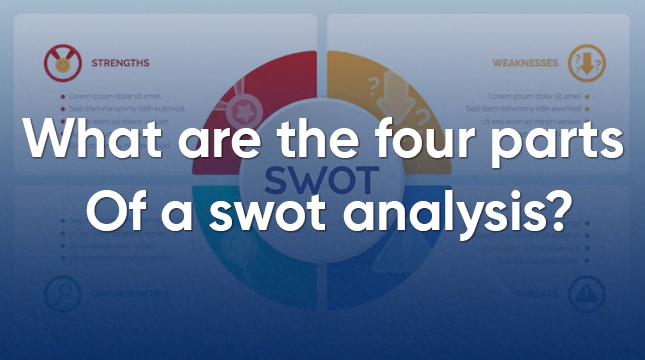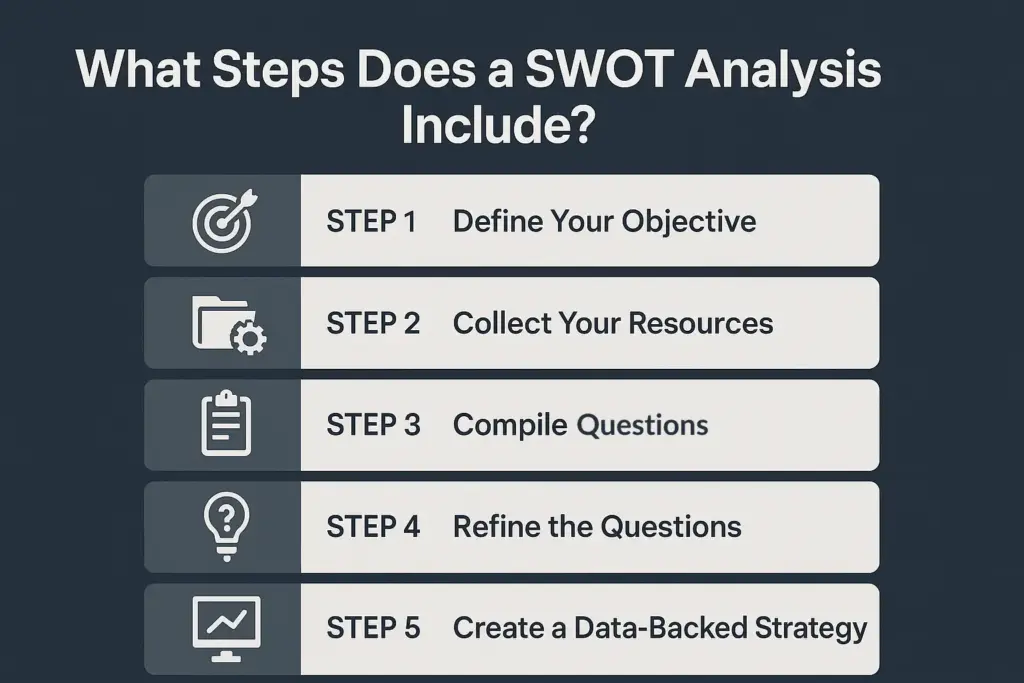This website uses cookies so that we can provide you with the best user experience possible. Cookie information is stored in your browser and performs functions such as recognising you when you return to our website and helping our team to understand which sections of the website you find most interesting and useful.
What are the Four Core Areas of SWOT Analysis?
Written by
NetizensMay 22, 2024
9 min read

A SWOT assessment is an in-depth assessment for business owners. It applies to existing companies and to startups. A SWOT analysis is what entrepreneurs must do after creating a business plan. It tests the feasibility of the startup idea, making it a crucial strategic planning tool that acknowledges the internal and external factors.
This blog details what SWOT assessments are and how to conduct them.
What Does SWOT Stand For?
SWOT has long been used as an abbreviation, but many are unaware of the full form or its use. The acronym ‘SWOT’ stands for Strengths, Weaknesses, Opportunities, and Threats.
Each of these four categories allows a company to assess and review its operations. Companies undertake a SWOT analysis to understand their position and their potential in a changing market.
What Does SWOT Mean?
SWOT analysis uses these four core areas to study a business and its position:
Strengths
This area will focus on the company’s unique selling point (USP) and why it’s ahead of competitors. These could be anything from high customer engagement to strong branding.
These strengths will form the foundation of your strategies to attract new investors and more customers.
Weaknesses
This covers all the points that are limiting a company or preventing it from experiencing success. These are crucial areas the business needs to work on to operate optimally.
Weaknesses that most companies face include poor branding, capital limitations, high turnover, and a low user base.
Opportunities
These describe the external situations that would favor the company and provide opportunities to overtake competitors.
Some opportunities are when tariffs decrease, using automation to boost business, or collaborating with another brand. Regular assessment of opportunities should occur, and the market can create unexpected openings.
Threats
Just as they could create opportunities, external factors can also create threats. Factors that can cause threats are new competitors, recessions, or technological service disruptions.
Accurately assessing the potential threats a business faces will require careful data analysis. Using data analytics consulting transforms businesses through vital data, and is an option in making a SWOT assessment.
What Steps Does a SWOT Analysis Include?
Conducting a thorough and accurate SWOT analysis is vital for making crucial business decisions.

Step 1: Define Your Objective
There are several reasons why a company may be conducting a SWOT analysis.
Reasons may be finding potential to enhance profitability or cut unnecessary costs. Alternatively, it could be to test the market’s reception for a new product launch. Either way, it’s done to gather information and put the company in a better position.
Quickly identifying the objective and sticking to it will be helpful in a successful SWOT assessment. This objective will chart a path and guide companies to their aims.
Step 2: Collect Your Resources
SWOT analysis results can be influenced by the information used to make the table. As a result, the support information available must be understood beforehand.
Without access to correct information, companies could proceed in the wrong direction. This makes it vital to assess access to information and the limitations before conducting the analysis.
Another consideration is which staff are involved in the analysis process. The staff who are most familiar with the company’s operations and position must be involved. They have a better perspective of the company and can provide valuable contributions.
Step 3: Compile Questions
The next step is to draft out a list of questions that could be used in the analysis. The strengths and weaknesses should focus on internal factors. Alternatively, the opportunities and threats should be focused on external factors.
The questions can be drafted and grouped based on the core area they address (Strengths, Weaknesses, Opportunities, and Threats).
Step 4: Refine the Questions
Once a sizable list is made, you can grade them and pick the relevant questions. Start to refine the questions, improving their value, and rate them based on quality.
The best questions could be broad or specialized, like how can technology solve business challenges? Focusing on improving the questions helps to polish the best ideas and bring forth meaningful assessments.
Step 5: Create a Data-Backed Strategy
After conducting the SWOT analysis, use the data derived from it to draw up a strategy. To gain a successful analysis, the staff members participating must take a specific situation into account.
Examples of scenarios that drive the analysis include launching a new product or expanding to a new market. Here, companies should analyze the following factors:
- Raw material costs
- Supply and distribution channels
- Staffing costs
- Unexpected product demand surges
- Potential to attract competitor customers
SWOT Model Example
Strengths
What are our company’s strengths?
What are we doing that our competitors aren’t?
Weaknesses
What areas can we improve on?
Which products are underperforming?
Opportunities
What external factors would favor our company?
What new channels can we find to expand our product reach?
Threats
What change in regulations would impact us?
What competitor-based factors would be harmful to our position?
How could consumer trend changes affect us?
SWOT Model Example With Answers
Strengths
Strong branding that has become widely recognizable.
Good product performance.
Weaknesses
Weak branding and limited marketing reach.
Select poorly performing products.
Opportunities
Lower tariffs and the easing of government regulations that favor the company.
A competitor exiting the market or losing market share.
The discovery of a potential target audience or demographic group.
Threats
Higher taxes and government regulations that don’t favor the company.
New competitors are entering the market or existing ones are increasing their share.
Failure to meet evolving consumer expectations.
What are Some Mistakes to Avoid During a SWOT Analysis?
Although SWOT assessments are group efforts, some errors can reduce the effectiveness of this exercise.
Overplaying Company Strengths
Companies that aren’t honest about their company’s weaknesses face a vulnerable future. Failure to be honest and confront the weaknesses leaves companies defenseless against future fluctuations.
Downplaying weaknesses mostly happens when companies overemphasize their strengths. The result is more optimism than realistic analysis, leading the organization down a dangerous path.
Shutting Out Broader Perspectives
An isolated analysis consisting of a small group of analysts and marketers is not ideal. This is especially true when feedback directly from stakeholders is absent.
During this analysis process, feedback from all employee levels is crucial. Each group holds a different perspective, and it benefits the company. Questions can be created based on each group’s interaction with and knowledge of the company.
Overvaluing Unimportant Factors
Another error area is when certain factors are prioritized over more important ones. Not all the weaknesses and threats are equivalent, so careful arrangement is necessary.
The inability to distinguish between the importance of factors can be detrimental to the business’s future. It can easily misalign the company’s progress by highlighting incorrect goals.
Not Conducting SWOT Analysis Often Enough
Many people make the mistake of conducting a SWOT analysis once and never again! This misconception is that it’s a one-time activity that doesn’t need to be repeated.
This strategic planning tool should be used as often to re-evaluate the company’s position. This is especially true for companies in fluctuating markets.
Conclusion
A SWOT analysis is a priceless guide that helps influence company direction. It generates effective marketing techniques to start a business or improve an existing one. This analysis provides valuable benefits, but it also has limitations.
It lays the foundation, but cannot be used alone to direct a company’s operations. Also, improper weighing of factors can lead to the ignoring of vital aspects.
FAQs
1. What is SWOT analysis used for?
2. What makes a good SWOT analysis?
3. What are the reasons a firm would use a SWOT analysis?
4. What are examples of weaknesses in SWOT?
5. What are the strengths in a SWOT analysis?

Let's Start Your Project
Get free consultation for your digital product idea to turn it into reality!
Get StartedRelated Blog & Articles

Netizens
March 17, 2023
Make Millions With Shopify Dropshipping (Here Is How)
Right now, a Shopify dropshipping business is a popular option. You can concentrate on marketing your

Netizens
May 23, 2024
Aniwave – Is it Really Worth It?
AniWave has emerged as a standout choice. Whether you're a seasoned otaku or a newcomer to

Netizens
January 27, 2025
Understanding Network Topology: A Comprehensive Guide
What is network topology, and why do the different types of it matter? Network topology is




